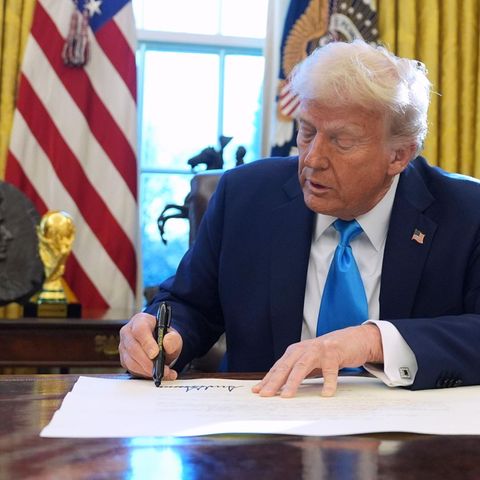In Argentina the debt crisis We usually understand them as the outcome of a period in which large amounts of debt are taken out in foreign currency (usually to cover current expenses), ignoring future payment capacity. In fact, in February former president Cristina Fernández de Kirchner published a document on “the third debt crisis” in the country.
According to the criteria covered, the three major Argentine debt crises occurred in 1975-1989, 1989-2001 and 2016-2024, in these cases the debt increased 14%, 8% and 7% per year, respectively. With Monday’s newspaper, it is reasonable to define these periods as “debt crises”, particularly with a growth in debt in these values, while GDP grew at 0.4%, 2% and -0.5% annually on average.
By having the capacity to issue dollars, in the United States the debt crisis does not have the same meaning or implications. Yeah, The US also has a debt crisis, even in recent years they have become increasingly recurrent. Placing the last ones in 2011, 2013 and 2023.
Until 1917 in the US, governments had to ask Congress for authorization to go into debt, but since then Congress has authorized a maximum debt ceiling (“ceiling”). Almost every year the roof is raised to keep up with the growth of local needs. The problem arose with the crisis of 2008. The US began to borrow at values much higher than previous values and surpassing the growth of its economy, to go from having a debt over GDP of 68% to 124% today (historical maximum). ).
image.png
It has something in common with Argentina, the stock of debt plays a role as a condition for governments that want to diverge from the precepts of cutting social spending provided by liberal economists. In the case of our country, the debt forces us to take measures of fiscal restriction, devaluations and/or regulations on the movement of capital, otherwise macroeconomic instability would be unsustainable. For the US, being forced to renew the debt ceiling annually, it must constantly negotiate spending cuts with Congress.
Although the need for negotiation has been in force since 1917, over the years the US became progressively more subordinated to debt to cover public spending. On the one hand, the country historically has a fiscal deficit, for example: of the last 100 years, it had it in 81 of them; On the other hand, while between 1947 and 2002 it resorted to credit to finance an average of 10% of its spending, since 2003 there has been a break in that figure, rising to 33% (with a maximum of 90% in 2020).
If we make a parallel with Argentina, since 2009 (since previous years in the 2000s there were surpluses) the deficit has been financed with debt, 9% of spending annually, on average.
image.png

In 2011, the US debt amounted to USD 14.4 trillion, while the ceiling was USD 14.3 trillion. There were several weeks of negotiation to obtain congressional approval to raise the ceiling. Meanwhile, with 40% of spending financed with debt, the prolongation of the solution generated costs in the economy: a 16% drop in the market, an increase in borrowing costs for that year for an estimated USD 1,740 million (at prices 2023), and suffer the first credit rating cut in the United States, going from AAA to AA+, from which it never recovers. The risk even raised insurance against one-year debt defaults (Credit Default Swaps-CDS) to a premium of 68 (the average is 22).
In 2013 it happened again, and was prolonged through an increase in collection and a cut in spending that led to a sharp reduction in the functioning of the government for 16 days due to the impossibility of paying salaries, although it was not enough. Finally, it was decided to temporarily suspend the ceiling, with the endorsement of the Republicans who sought to have power over the Democrats in Congress and the president. The CDS rise again to a premium of 60.
Recently in 2023 it happens again, although largely because between 2013 and 2021 much of the time the ceiling was suspended. The Government tried to ensure that the Republicans did not impose conditions in this negotiation, giving rise to the situation that both political parties threatened to allow the US default to occur. Finally, a new suspension of the debt ceiling until 2025 is signed, in exchange for some limits on spending. This time CDS increases its premium to 156, the highest on record.
It is worth taking note of the ease of indebtedness that the US has, which led it to neglect the amount of accumulated debt. Since 2009, the cost of 10-year debt amounts to 2.4% annually on average, with slightly lower inflation; while in the previous 30 years it was close to 7.5%, although with an inflation of 3.8%. The advantages of being an issuer of the currency considered a reserve of value worldwide thanks to its geopolitical strength and relative stability. In fact, since the 2008 crisis, the debt held by international investors has stood at 30% (somewhat declining in recent years), while the 30 years prior to the crisis it amounted to 17%. That is, while the US needed resources to finance its spending, it had demand for its bonds from its Central Bank system and the rest of the World.
In any case, it is also a disadvantage when considering the possible consequences of one day not increasing the debt ceiling. In terms of debt, it is a problem since interest on debt and public spending have to be paid daily and, if a maturity occurs that cannot be paid with new debt, default would occur. In addition to the local implications, the fact that the “strongest” currency at an international level loses its stability would risk putting in check the rest of the world, which largely prices its assets in relation to the dollar.
Economist at CIEN (National Economy Research Center)
Source: Ambito
David William is a talented author who has made a name for himself in the world of writing. He is a professional author who writes on a wide range of topics, from general interest to opinion news. David is currently working as a writer at 24 hours worlds where he brings his unique perspective and in-depth research to his articles, making them both informative and engaging.




